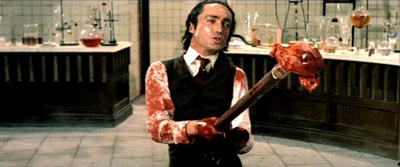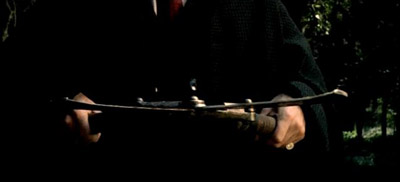Flesh for Frankenstein, 1973, written and directed by Paul Morrissey, characters created by Mary Shelley.
Paul Morrissey made this movie immediately before Blood for Dracula; I liked it less, although it's pretty good. (I do mean "immediately before," incidentally—they wrapped Flesh for Frankenstein one fine morning, had lunch, and started shooting Blood for Dracula). As with Blood for Dracula, Morrissey has nothing good to say about modern permissiveness. Flesh for Frankenstein has one thing Blood for Dracula doesn't, though: Spacevision 3-D! Which means you get shots like this:

Udo Kier as Dr. Frankenstein, with his heart on
his sleeve and his stomach on a pole.
A bit about 3-D; as you probably know, 3-D works by presenting the left and right eye with a different image, photographed simultaneously with two lenses that are about as far apart as the human eyes. As in the real world, the brain interprets the slight differences in perspective between the two images as depth, and thus images seem to stand out from the screen. The differences in various 3-D formats have to do with how the images are isolated in each eye. I've seen four 3-D movies actually in 3-D, and three of them were at Disney theme parks (Captain Eo, Honey, I Shrunk The Audience, and The Muppets Present: Medea! Ok, I can't remember the name of the Muppet movie). The fourth 3-D movie I saw was The Creature From The Black Lagoon, which used the analglyph duo-color red-blue system. If you've ever seen an analglyph duo-color 3-D movie or image, you know the effect is not so great, the depth of color is limited, and your eyes get tired from watching them. So my impression was always that the Disney systems required a very expensive projector or some sort of heavy equipment to use polarized light;1 I didn't think there was ever a mass-market format that used that kind of 3-D effect.
I was wrong. The first 3-D process, NaturalVision, used polarized light. It also required simultaneous projection using two projectors, and was therefore prone to go wrong. Most movie theaters could do dual projection (they had two projectors for reel changes), but if the projectors weren't in sync, the 3-D effect was spoiled. Poor presentation quality may, in fact, be what killed 3-D off as a commercial medium; I shudder to think what the format would look like now that there are so few theaters with even moderately skilled projectionists. If you're interested in the history of 3-D film, there's a good summary here.
SpaceVision was a one-strip process, designed to eliminate the errors that two-strip projection introduced (my understanding is that the projector had a specialized dual lens); but like NaturalVision, it used polarization rather than a duo-tone system. So as you can see above, you get the same depth of color you would with any one-strip color system of the time. Plus it's in 3-D!
Except, of course, it isn't. Televisions can't show things in SpaceVision. So this is the first Criterion DVD where the image on screen is not just inevitably worse (because lower res) than a theatrical presentation, but different in kind. So if anyone ever screens this in SpaceVision near me, believe me, I'll be there.
So the end result of watching a 3-D movie on a television is that there are lots of strange shot compositions that don't make much sense; there's always something in the foreground and people keep waving flowers, knives, and organs directly at the screen. Also, in contrast to the deep colors of Blood for Dracula, this movie seemed overlit to me. Morrissey talks on the commentary track about how much he hates underlit films and naturalistic lighting; in both Blood for Dracula and Flesh For Frankenstein, he just kind of throws lights on his actors. Which looks great in a 30's sort of way, in Blood for Dracula, but feels overdone here.
The movie's a pretty far departure from Mary Shelley's story. In this version, Dr. Frankenstein (Udo Kier, who's great as always) is trying to create a super race of racially pure zombies. As a result, he's reanimated not just one corpse, but two, both designed to be irresistably beautiful. His goal is to get them to breed; he has a LaMarkian understanding of genetics, and believes their offspring will be as perfect as they are. The female monster, played by the ridiculously attractive Dalila Di Lazzaro, is an unmitigated success. But as the movie opens, he's still looking for a perfect head for his male monster. He wants a sexual powerhouse, so he hangs out outside of a brothel looking for someone with unstoppable, racially-pure sex know-how. Unfortunately, he goes looking for his head on the same day that Joe Dallesandro convinces his friend Sacha to try sleeping with girls before becoming a chaste monk. In the brothel, Sacha completely ignores the girl he's with while sending longing, languid looks in Joe's direction—so guess whose head ends up on the monster?
It's certainly a funny enough variation, but Udo Kier's Baron Frankenstein never quite rises to the level of tragic the way his Dracula does. Perhaps Dracula is just inherently sexier than Frankenstein, in the same way that blood is sexier than shit. Because man, is this movie ever interested in human viscera. I would guess that 75% of the on-screen deaths are by disemboweling; the only exceptions are Sacha and the Baroness. And these aren't subtle deaths; the effects are by Carlo Rambaldi, who went on to design effects in Alien. Let's just say he used a lot of animal organs in this movie; the still above is one of the tamer examples.
So it's not as good, on the whole, as Blood for Dracula. That said, it has one moment that's funnier than anything else in either movie; Frankenstein's monster has chased him out of his own laboratory and slammed the gate on his hand, severing it (you can see above that Kier's left hand is missing). The doctor staggers back in and retrieves his hand; he tries to reattach it, fails, realizes that he's dying, and throws his own hand at Joe Dallesandro in a fit of rage. Which is pretty much exactly how most people would react in that situation. Kier does this sort of spoiled-child routine as part of his character in both movies; that's its apotheosis.
That's all for this one; sorry about the extended, wonky discussion of 3-D. I leave you with the following still; SpaceVision at its most terrifying:

Here comes a chopper to chop off your head!
1There is, in fact, a more expensive and complicated system for separating images than using polarized light; IMAX produces 3-D movies that use glasses with timed LCD shutters, so that each eye sees every other frames (i.e., for frame one, the left eye's lens is opaque, for frame two the right eye lens is opaque). However, the difficulty of syncing the glasses with the projection make this even less practical than a dual projector polarization system in terms of costs and projectionist training.
Update (9-20-2006): I was fortunate enough to see Flesh For Frankenstein in 3-D Saturday night at the Egyptian Theatre here in Hollywood as part of the second World 3-D Exposition. It was a new print, but a strange one, in that it seemed to be a letterboxed 4:3 frame. In any event, it was in 3-D, which was an entirely different experience than watching the DVD. Kier's death speech is fantastic when the spear that's run him through is hovering in front of your face. Best of all, Udo Kier was there for a pre-movie Q & A (he told the same story Morrisey tells on the commentary track about casting him in Blood for Dracula), and watched the movie with the audience, the second time he'd seen it in 3-D since it was made.


6 comments:
I ran across this web site while researching 3D process technology.
My father was the inventor of
Spacevision and a Naturama system in the '50's. He was the director of photography on the Flesh for Frankenstein film. Would like to hear anything regarding thoughts or information regarding this subject.
respond to: bouquetcreek@cs.com
Anonymous,
Fantastic -- I'll respond via email.
Paul Morrissey says he cast Joe Dellasandro in Flesh For Frankenstein because Dellasandro was a star in Europe and his name would help at the European box office. Being a good-looking guy willing to appear naked explains all of his appeal. But it seems like you can get someone with a degree to pontificate on almost anything on a commentary track. Here Maurice Yacowar describes Joe Dellasandro’s presence as “an anachronism in a European costume drama, reminding us that everything in Flesh For Frankenstein stems from genre convention, that it is all posing and playing with no pretense to realism.” Yeah, Dellasandro’s an anachronism, but that’s because he’s a genuinely bad actor.
This film is sporadically amusing but largely inane (in spite of the Gustav Klimt- inspired art direction and the beautifully melodic score). There is controversy about the inclusion of certain films by Criterion in their catalog, but Flesh For Frankenstein is for me Criterion’s first serious misstep. If the original impetus for making Flesh For Frankenstein was the 3-D technology, if the 3-D form matches content (Morrissey’s lampooning of the audience’s insatiable hunger for sex and gore), and if it is Criterion’s mission to show these films in the best possible light, then it makes no sense to view this film in any way other than 3-D.
John B. - one can hope that FLESH FOR FRANKENSTEIN gets a Criterion re-release in Blu-Ray 3D. You're right, and so's Matt - the only way this movie makes sense is in 3D....
Timothy,
You're right, they could do that now--I hadn't thought of it. God, would that mean I'd have to buy a 3D HDTV? Boo!
Please Criterion… finally release this on Blu-ray in 3-D! The only way it was ever meant to be seen!!
Post a Comment